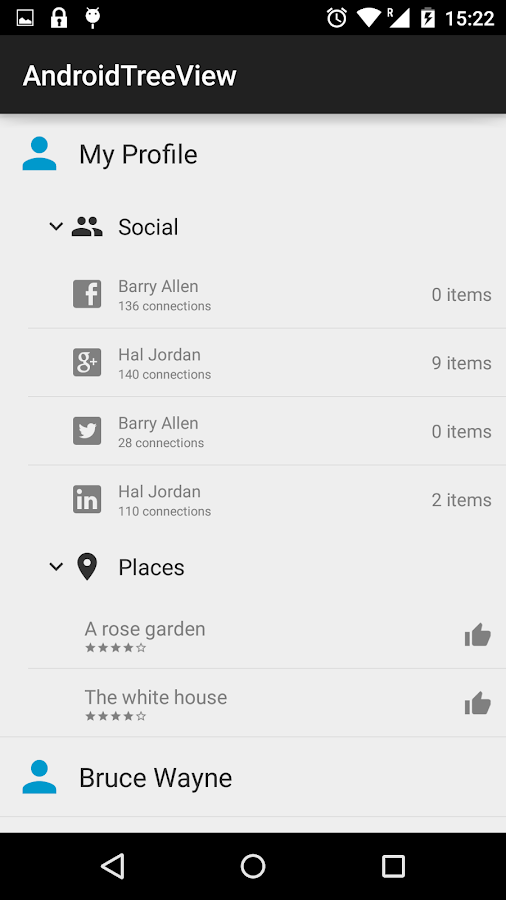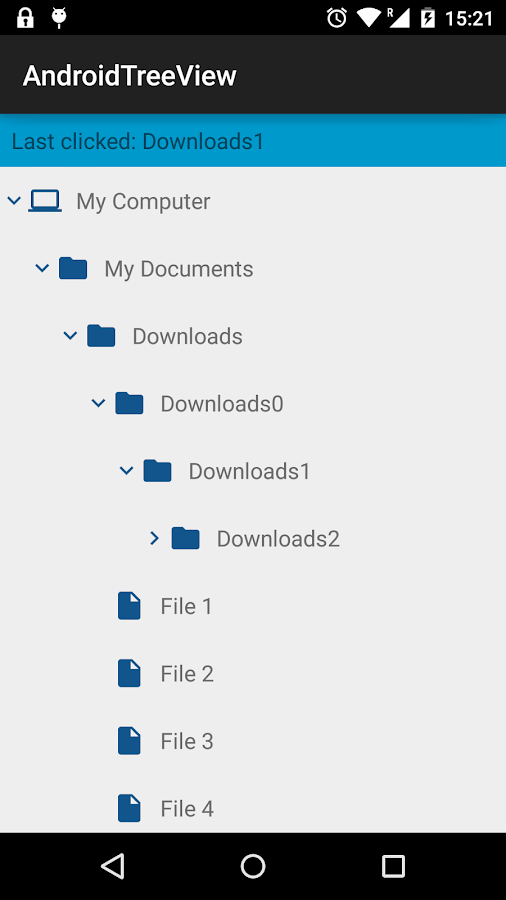# AndroidTreeView
**Repository Path**: android_locker/AndroidTreeView
## Basic Information
- **Project Name**: AndroidTreeView
- **Description**: No description available
- **Primary Language**: Unknown
- **License**: Apache-2.0
- **Default Branch**: master
- **Homepage**: None
- **GVP Project**: No
## Statistics
- **Stars**: 0
- **Forks**: 0
- **Created**: 2020-12-11
- **Last Updated**: 2020-12-19
## Categories & Tags
**Categories**: Uncategorized
**Tags**: None
## README
AndroidTreeView
====================
### Recent changes
2D scrolling mode added, keep in mind this comes with few limitations: you won't be able not place views on right side like alignParentRight. Everything should be align left. Is not enabled by default
### Description
Tree view implementation for android
[](https://android-arsenal.com/details/1/1534)
### Demo
[](https://play.google.com/store/apps/details?id=com.unnamed.b.atv.demo)
### Features
+ 1. N - level expandable/collapsable tree
+ 2. Custom values, views, styles for nodes
+ 3. Save state after rotation
+ 4. Selection mode for nodes
+ 5. Dynamic add/remove node
### Known Limitations
+ For Android 4.0 (+/- nearest version) if you have too deep view hierarchy and with tree its easily possible, your app may crash



 ### Integration
**1)** Add library as a dependency to your project
```compile 'com.github.bmelnychuk:atv:1.2.+'```
**2)** Create your tree starting from root element. ```TreeNode.root()``` element will not be displayed so it doesn't require anything to be set.
```java
TreeNode root = TreeNode.root();
```
Create and add your nodes (use your custom object as constructor param)
```java
TreeNode parent = new TreeNode("MyParentNode");
TreeNode child0 = new TreeNode("ChildNode0");
TreeNode child1 = new TreeNode("ChildNode1");
parent.addChildren(child0, child1);
root.addChild(parent);
```
**3)** Add tree view to layout
```java
AndroidTreeView tView = new AndroidTreeView(getActivity(), root);
containerView.addView(tView.getView());
```
The simplest but not styled tree is ready. Now you can see ```parent``` node as root of your tree
**4)** Custom view for nodes
Extend ```TreeNode.BaseNodeViewHolder``` and overwrite ```createNodeView``` method to prepare custom view for node:
```java
public class MyHolder extends TreeNode.BaseNodeViewHolder {
...
@Override
public View createNodeView(TreeNode node, IconTreeItem value) {
final LayoutInflater inflater = LayoutInflater.from(context);
final View view = inflater.inflate(R.layout.layout_profile_node, null, false);
TextView tvValue = (TextView) view.findViewById(R.id.node_value);
tvValue.setText(value.text);
return view;
}
...
public static class IconTreeItem {
public int icon;
public String text;
}
}
```
**5)** Connect view holder with node
```java
IconTreeItem nodeItem = new IconTreeItem();
TreeNode child1 = new TreeNode(nodeItem).setViewHolder(new MyHolder(mContext));
```
**6)** Consider using
```java
TreeNode.setClickListener(TreeNodeClickListener listener);
AndroidTreeView.setDefaultViewHolder
AndroidTreeView.setDefaultNodeClickListener
...
```
For more details use sample application as example
Let me know if i missed something, appreciate your support, thanks!
### Projects using this library
[Blue Dot : World Chat](https://play.google.com/store/apps/details?id=com.commandapps.bluedot)
### Integration
**1)** Add library as a dependency to your project
```compile 'com.github.bmelnychuk:atv:1.2.+'```
**2)** Create your tree starting from root element. ```TreeNode.root()``` element will not be displayed so it doesn't require anything to be set.
```java
TreeNode root = TreeNode.root();
```
Create and add your nodes (use your custom object as constructor param)
```java
TreeNode parent = new TreeNode("MyParentNode");
TreeNode child0 = new TreeNode("ChildNode0");
TreeNode child1 = new TreeNode("ChildNode1");
parent.addChildren(child0, child1);
root.addChild(parent);
```
**3)** Add tree view to layout
```java
AndroidTreeView tView = new AndroidTreeView(getActivity(), root);
containerView.addView(tView.getView());
```
The simplest but not styled tree is ready. Now you can see ```parent``` node as root of your tree
**4)** Custom view for nodes
Extend ```TreeNode.BaseNodeViewHolder``` and overwrite ```createNodeView``` method to prepare custom view for node:
```java
public class MyHolder extends TreeNode.BaseNodeViewHolder {
...
@Override
public View createNodeView(TreeNode node, IconTreeItem value) {
final LayoutInflater inflater = LayoutInflater.from(context);
final View view = inflater.inflate(R.layout.layout_profile_node, null, false);
TextView tvValue = (TextView) view.findViewById(R.id.node_value);
tvValue.setText(value.text);
return view;
}
...
public static class IconTreeItem {
public int icon;
public String text;
}
}
```
**5)** Connect view holder with node
```java
IconTreeItem nodeItem = new IconTreeItem();
TreeNode child1 = new TreeNode(nodeItem).setViewHolder(new MyHolder(mContext));
```
**6)** Consider using
```java
TreeNode.setClickListener(TreeNodeClickListener listener);
AndroidTreeView.setDefaultViewHolder
AndroidTreeView.setDefaultNodeClickListener
...
```
For more details use sample application as example
Let me know if i missed something, appreciate your support, thanks!
### Projects using this library
[Blue Dot : World Chat](https://play.google.com/store/apps/details?id=com.commandapps.bluedot)